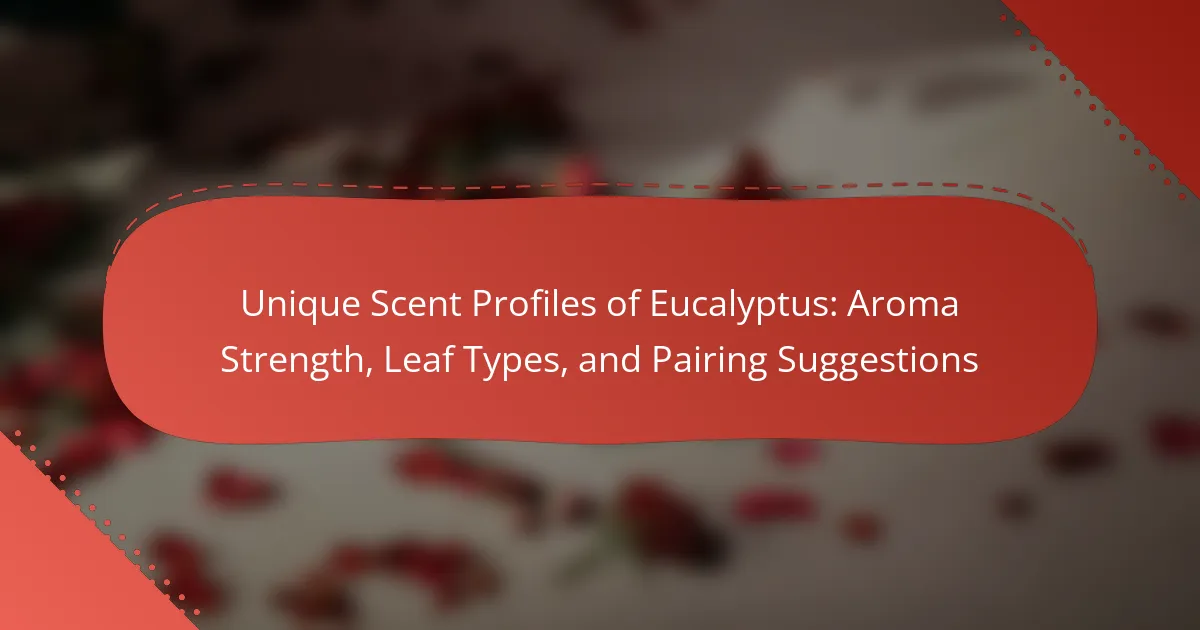
What are the Unique Scent Profiles of Eucalyptus?
Eucalyptus has a distinctive scent profile characterized by fresh, crisp, and slightly sweet notes. This aroma is often described as invigorating and refreshing. Different species of eucalyptus contribute unique variations to the scent. For example, Eucalyptus globulus has a strong, camphorous aroma, while Eucalyptus radiata offers a milder, sweeter scent. The scent profile can also vary based on the leaf type and oil extraction method. Eucalyptus essential oil is commonly used in aromatherapy for its uplifting properties. Studies indicate that inhaling eucalyptus aroma can enhance mental clarity and reduce stress.
How do different aroma strengths influence the perception of eucalyptus scent?
Different aroma strengths significantly influence the perception of eucalyptus scent. Stronger aromas are often perceived as more invigorating and refreshing. They can evoke a sense of clarity and energy. In contrast, milder aromas may be experienced as soothing and calming. This variation affects emotional responses and preferences for eucalyptus in aromatherapy. Research indicates that aroma intensity impacts olfactory perception and emotional engagement. A study published in the Journal of Sensory Studies found that higher aroma concentrations enhance the perception of freshness. Thus, aroma strength plays a crucial role in how eucalyptus scent is experienced.
What factors contribute to the aroma strength of eucalyptus?
The aroma strength of eucalyptus is influenced by several factors. The primary factor is the concentration of essential oils in the leaves. Eucalyptus leaves contain compounds such as eucalyptol, which contribute significantly to the aroma. The age of the leaves also plays a role; younger leaves tend to have a stronger aroma due to higher oil content. Environmental conditions, such as soil quality and climate, affect the growth and oil production of eucalyptus plants. Additionally, the specific species of eucalyptus influences aroma strength; some species are naturally more aromatic than others. Harvesting methods can impact oil retention, further affecting aroma strength. Lastly, the method of extraction used for essential oils can enhance or diminish the aromatic profile.
How does aroma strength vary among eucalyptus species?
Aroma strength varies significantly among eucalyptus species. For instance, Eucalyptus globulus, commonly known as blue gum, has a strong, menthol-like aroma. In contrast, Eucalyptus citriodora, or lemon eucalyptus, offers a milder, lemon-scented aroma. Eucalyptus radiata presents a balanced scent that is less intense than E. globulus but more potent than E. citriodora. The variation in aroma strength is due to the different concentrations of essential oils present in each species. Research indicates that the chemical composition of these oils directly influences aroma intensity. For example, E. globulus has higher cineole content, contributing to its robust scent. Thus, aroma strength among eucalyptus species is influenced by their unique chemical profiles and essential oil concentrations.
What types of eucalyptus leaves are commonly recognized?
The commonly recognized types of eucalyptus leaves include Eucalyptus globulus, Eucalyptus citriodora, and Eucalyptus radiata. Eucalyptus globulus, known as the blue gum, has a strong aroma and is often used for medicinal purposes. Eucalyptus citriodora, or lemon eucalyptus, is noted for its citrus scent and insect-repelling properties. Eucalyptus radiata, referred to as narrow-leaved peppermint, has a milder aroma and is commonly used in aromatherapy. These varieties are well-documented for their distinct scent profiles and applications in various industries.
What are the distinguishing features of different eucalyptus leaf types?
Eucalyptus leaves vary significantly in shape, size, and color, distinguishing different species. The juvenile leaves are typically rounded and blue-green, while [censured] leaves are elongated and lanceolate. [censured] leaves often have a glossy appearance and can be dark green or greyish-green. Some species, like Eucalyptus globulus, feature aromatic oils concentrated in their leaves, enhancing their scent profile. Additionally, leaf margin types can vary; some are smooth, while others have serrated edges. These features contribute to the unique scent profiles of each eucalyptus type, influencing their use in aromatherapy and essential oils.
How do various leaf types affect the scent profile?
Various leaf types of eucalyptus significantly influence the scent profile. Different species produce distinct aromatic compounds. For instance, Eucalyptus globulus has a strong menthol scent due to high cineole content. In contrast, Eucalyptus citriodora offers a lemony aroma from citronellal. Leaf maturity also affects scent; younger leaves often have a more intense fragrance. Additionally, environmental factors like soil and climate can alter the chemical composition of the leaves. Research shows that these variations contribute to the unique aromatic experiences associated with each eucalyptus type.
Why is understanding eucalyptus scent profiles important?
Understanding eucalyptus scent profiles is important for various applications. Different eucalyptus species produce distinct aromas. These scent profiles can influence mood and well-being. For instance, some scents are known for their calming effects. Others may enhance focus or energy levels. Aromatherapists use these profiles to tailor treatments. Additionally, the fragrance industry relies on specific scent characteristics for product development. Knowledge of eucalyptus scent profiles aids in creating effective blends and enhancing user experience.
How can scent profiles enhance aromatherapy practices?
Scent profiles enhance aromatherapy practices by providing specific therapeutic benefits tailored to individual needs. Each scent profile, such as eucalyptus, has unique properties that can promote relaxation, reduce stress, or invigorate the mind. For example, eucalyptus oil is known for its refreshing aroma, which can clear the respiratory system. This specific scent can enhance focus and mental clarity, making it ideal for use during meditation or study.
Research indicates that different scent profiles can evoke distinct emotional responses. A study published in the Journal of Alternative and Complementary Medicine found that participants exposed to eucalyptus reported lower levels of anxiety and improved mood. By selecting appropriate scent profiles, practitioners can create customized experiences that align with their goals, whether for relaxation, energy, or mental clarity.
What role does eucalyptus play in natural fragrances?
Eucalyptus plays a significant role in natural fragrances by providing a fresh, clean, and invigorating scent. This aromatic profile is often described as camphorous and slightly sweet. Eucalyptus essential oil is derived from the leaves of the eucalyptus tree, primarily Eucalyptus globulus. It is commonly used in aromatherapy and perfumery for its uplifting properties. The scent of eucalyptus can enhance mood and promote relaxation. Additionally, it serves as a base note in many fragrance blends. Its unique aroma pairs well with citrus, mint, and woody notes, making it versatile in fragrance formulations. Eucalyptus is also known for its potential antimicrobial properties, adding a functional aspect to its use in natural fragrances.
How can eucalyptus scents be paired with other aromas?
Eucalyptus scents can be paired effectively with citrus aromas like lemon and orange. The freshness of eucalyptus complements the bright notes of citrus. This combination can create an uplifting and energizing atmosphere. Additionally, eucalyptus pairs well with herbal scents such as rosemary and mint. These herbs enhance eucalyptus’s refreshing qualities. Floral notes like lavender also blend nicely with eucalyptus. This pairing adds a calming effect to the scent profile. Moreover, woody aromas like cedarwood can provide a grounding balance to eucalyptus. This combination creates a harmonious and earthy scent experience.
What are the best complementary scents for eucalyptus?
The best complementary scents for eucalyptus include peppermint, lemon, and tea tree. Peppermint enhances eucalyptus with its fresh and invigorating aroma. Lemon adds a bright and uplifting note that balances eucalyptus’s earthiness. Tea tree, known for its medicinal scent, harmonizes well with eucalyptus, creating a refreshing blend. These combinations are frequently used in aromatherapy and natural products. Their effectiveness is supported by their common use in essential oil blends, which highlights their compatibility.
How do pairing suggestions enhance the overall aroma experience?
Pairing suggestions enhance the overall aroma experience by creating complementary scent profiles. When combined with eucalyptus, certain fragrances can amplify its refreshing notes. For instance, pairing eucalyptus with citrus scents can intensify its invigorating qualities. This synergy allows for a more harmonious and balanced aroma. Research indicates that specific combinations can evoke stronger emotional responses. Studies show that scent blending can improve mood and relaxation. Thus, careful pairing transforms the aroma experience into a more enjoyable and enriching one.
What are some practical tips for utilizing eucalyptus scents effectively?
To utilize eucalyptus scents effectively, consider using essential oils in a diffuser. This method disperses the aroma throughout the space. Adjust the number of drops based on the room size for optimal strength. For a more targeted approach, apply diluted eucalyptus oil to pulse points. This allows for personal inhalation of the scent. Mixing eucalyptus with complementary oils, like lavender or lemon, enhances its therapeutic effects. Use eucalyptus in cleaning products for a fresh, invigorating scent. Additionally, incorporating eucalyptus in bath products can promote relaxation. Always ensure proper ventilation when using concentrated scents.
The primary entity of this article is eucalyptus, specifically its unique scent profiles characterized by varying aroma strengths, leaf types, and complementary pairing suggestions. The article explores how different eucalyptus species, such as Eucalyptus globulus and Eucalyptus citriodora, contribute distinct aromas influenced by factors like essential oil concentration and environmental conditions. Additionally, it discusses the emotional and therapeutic benefits of eucalyptus scents in aromatherapy and natural fragrances, along with practical tips for effective utilization. The information is structured to provide a comprehensive understanding of eucalyptus scent profiles and their applications.
